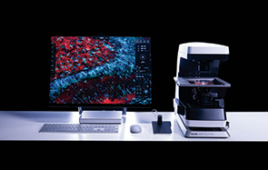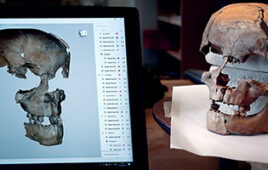
Images show the whole cortical surface of the mouse at six weeks and 36 weeks after implantation of the See-Shell. Researchers found that the See-Shell could be safely implanted over long durations of time, which opens up long-term options for brain research. Credit: Ghanbari et. al., University of Minnesota
Researchers at the University of Minnesota have developed a unique 3D-printed transparent skull implant for mice that provides an opportunity to watch activity of the entire brain surface in real time. The device allows fundamental brain research that could provide new insight for human brain conditions such as concussions, Alzheimer’s and Parkinson’s disease.
The research is published in Nature Communications. Researchers also plan to commercialize the device, which they call See-Shell.
“What we are trying to do is to see if we can visualize and interact with large parts of the mouse brain surface, called the cortex, over long periods of time. This will give us new information about how the human brain works,” said Suhasa Kodandaramaiah, Ph.D., a co-author of the study and University of Minnesota Benjamin Mayhugh Assistant Professor of Mechanical Engineering in the College of Science and Engineering. “This technology allows us to see most of the cortex in action with unprecedented control and precision while stimulating certain parts of the brain.”
In the past, most scientists have looked at small regions of the brain and tried to understand it in detail. However, researchers are now finding that what happens in one part of the brain likely affects other parts of the brain at the same time.
One of their first studies using the See-Shell device examines how mild concussions in one part of the brain affect other parts of the brain as it reorganizes structurally and functionally. Kodandaramaiah said that mouse brains are very similar in many respects to human brains, and this device opens the door for similar research on mice looking at degenerative brain diseases that affect humans such as Alzheimer’s or Parkinson’s disease.
The technology allows the researchers to see global changes for the first time at an unprecedented time resolution. In a video produced using the device, changes in brightness of the mouse’s brain correspond to waxing and waning of neural activity. Subtle flashes are periods when the whole brain suddenly becomes active. The researchers are still trying to understand the reason for such global coordinated activity and what it means for behavior.
“These are studies we couldn’t do in humans, but they are extremely important in our understanding of how the brain works so we can improve treatments for people who experience brain injuries or diseases,” said Timothy J. Ebner, M.D., Ph.D., a co-author of the study and a University of Minnesota Professor and Head of the Department of Neuroscience in the Medical School.
To make the See-Shell, researchers digitally scanned the surface of the mouse skull and then used the digital scans to create an artificial transparent skull that has the same contours as the original skull. During a precise surgery, the top of the mouse skull is replaced with the 3D-printed transparent skull device. The device allows researchers to record brain activity simultaneously while imaging the entire brain in real time.
Another advantage to using this device is that the mouse’s body did not reject the implant, which means that the researchers were able to study the same mouse brain over several months. Studies in mice over several months allow researchers to study brain aging in a way that would take decades to study in humans.
“This new device allows us to look at the brain activity at the smallest level zooming in on specific neurons while getting a big picture view of a large part of the brain surface over time,” Kodandaramaiah said. “Developing the device and showing that it works is just the beginning of what we will be able to do to advance brain research.”
In addition to Kodandaramaiah and Ebner, the research team was led by fourth-year mechanical engineering Ph.D. student Leila Ghanbari. The research team included several post-doctoral associates, graduate students and undergraduate students including Russell E. Carter (neuroscience), Matthew L. Rynes (biomedical engineering), Judith Dominguez (mechanical engineering), Gang Chen (neuroscience), Anant Naik (biomedical engineering), Jia Hu (biomedical engineering), Lenora Haltom (mechanical engineering), Nahom Mossazghi (neuroscience), Madelyn M. Gray (neuroscience) and Sarah L. West (neuroscience). The team also included partners at the University of Wisconsin including researcher Kevin W. Eliceiri and graduate student Md Abdul Kader Sagar.
The research was funded primarily by the National Institutes of Health (NIH) with additional support from Minnesota’s Discovery, Research, and InnoVation Economy (MnDRIVE) funding from the State of Minnesota. Several undergraduate students involved in the research were supported by the University of Minnesota Undergraduate Research Opportunities Program (UROP). The imaging research was made possible by the cutting-edge imaging infrastructure at the University Imaging Center.
To read the full research paper, entitled “Cortex-wide neural interfacing via transparent polymer skulls,” visit the Nature Communications website.




